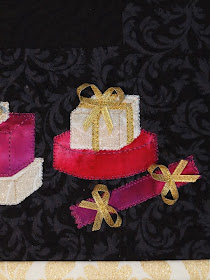I designed it last summer, after a morning of strawberry picking with James and Eleanor - although the design did evolve as I made it. The name comes from a simple family recipe, which is excellent when you pick far too many strawberries and the last of them start to soften a little.
It's all done with fused applique (and a little thread-painting) and the stems are all straight strips cut on the bias and gently eased to form the curves.
It's 39in square - designed to fit conveniently on standard-width fabric. The background fabric I used was rather more creamy than pink, but by quilting all the feathers in pale pink Aurifil, I've boosted the pink to make it look more like the mousse. The feathers were inspired by Wendy of Ivory Spring, and I love the way they came out. They were actually fairly quick to quilt, too.
The applique is done in free-motion, stitching twice around the very edge of each shape twice, and is done after sandwiching, so it's the quilting as well.
(before quilting)
I love all the little curlicues on the side sections, even if they're not true to strawberry plants.
I did work hard to make the blossoms realistic though, using thread to quilt/draw the pale green representing the calyx visible between the petals, then going over that in the centre with yellow threads. These additions also help to make the white flowers stand out better - they also show up better in person.
The pots in the corners conveniently came out of a small scrap of a print from Kate Spain's Central Park. I rarely use my scrap box, since only the smallest of pieces go in there, but I recently had to upgrade to a larger tub, so it was nice to get both the pots and the flowers from there.
Some of my recent posts explain a bit more of the process - and if you want to make your own; keep an eye out for AP&Q from March next year.
Thank you for visiting my Bloggers' Quilt Festival applique quilt entry; I hope you'll be back! If you haven't already, enjoy the others, here.
Frozen Strawberry Mousse:
1 lb fresh strawberries (it's ok if they're starting to soften - you can often buy cheaper 'jam' strawberries which are fine, too)
1 cup caster sugar
Extra quarter cup caster sugar
1 cup thickened cream, whipped
Juice of half a lemon
2 large egg whites
Mash the strawberries – don’t overdo it (a potato hand masher is perfect but slow; if using a stabmix, use very short pulses - you don't want puree). Add the sugar and lemon juice and stir until the sugar is dissolved. Whip egg whites stiffly and gradually add the extra sugar. Carefully fold together the strawberries, egg whites and whipped cream and pour into a wet quart mould/pudding basin). Cover and place in freezer. Allow about 12h to freeze.












































